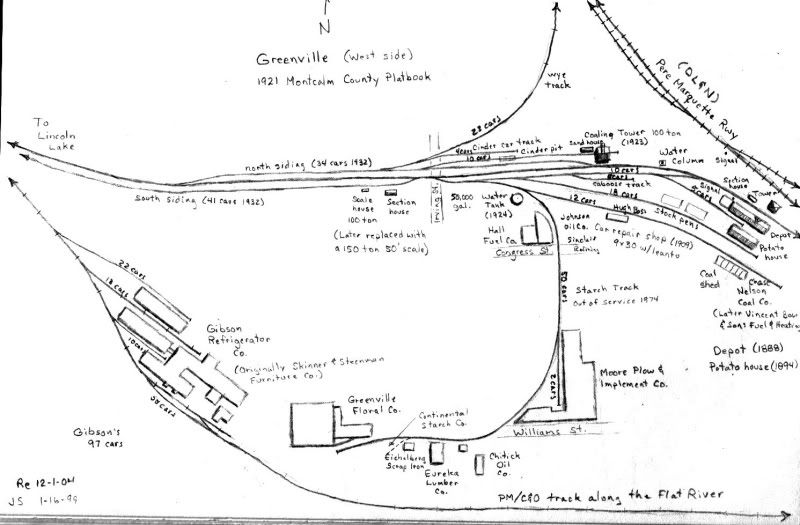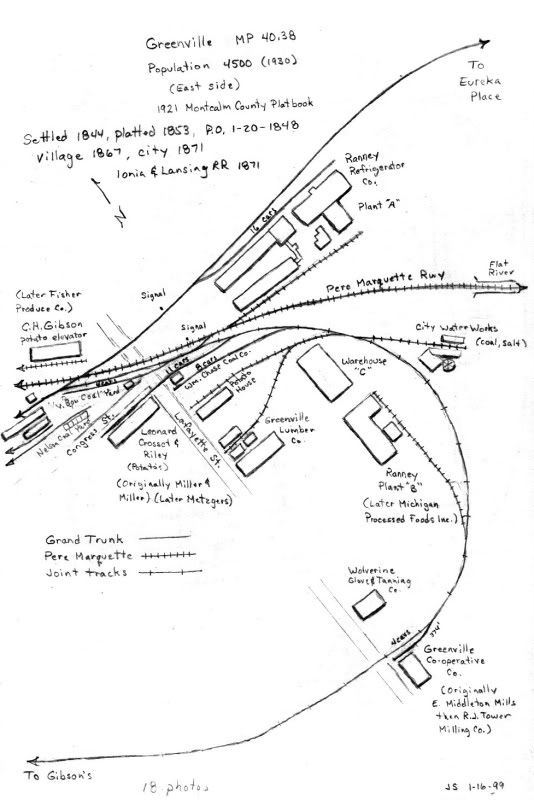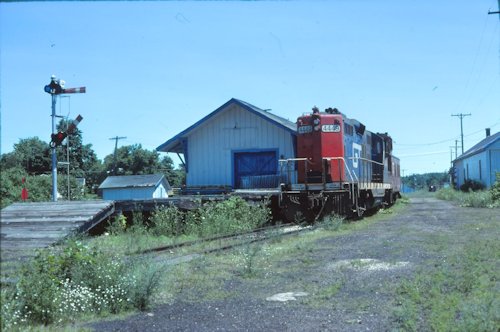Greenville
Here is couple of maps from a journal I keep on the GTW's "Turkey Trail". I have hand drawn maps of every station and other information. Into the early 1950's potatoes were shipped by rail and Greenville for years had been one of the largest shipping points for potatoes in the world. Greenville had two potato processing plants. The first was Michigan Processed Foods that was in operation from 1946 to the early 1950's. The other plant was Ore Ida Foods from the early 1960's until the 1980's.

As a boy my Grandmother lived across the street from the Gibson factory. I remember boxcars at the lumber company and gondolas at the scrap metal yard just down the street from her house. This traffic lasted into the early 1970's. Gibson was switched every day shipping out 20 or more cars a day.

The Ranney factory was switched as needed, a couple of cars a day. The rest of the GTW traffic was at the depot. Boxcars of newsprint and bagged cement at the loading dock behind the depot. Farm machinery at the former TOFC dock on the track next to the freighthouse/potato house. The TOFC dock is one of the few things remaining at the GTW yard. Up until the late 1950's Greenville had a LCL/express car delivered every other day at the freight house. This was an old wooden GTW 40' boxcar. I remember gondolas of storm sewer pipe on the Greenville city water works track.
Yes it did. When Gibson's expanded the plant in 1968 the connection was severed. I know the C&O switched the back side of the plant and the GTW switched the north side. I'm not sure if the C&O also switched the north side or if the GTW switched the C&O cars and the C&O picked them up. I don't remember seeing the C&O on the north side. Paul can you help? TNYes, the C&O had access to the entire Gibson complex, at least from the early 50s. The GTW always switched them during Gibson's lunch break between 1130-1200 while the C&O afternoon crew would go there around 1700 before heading to Edmore. Later when Gibson added a second shift the C&O Lowell local would give them an additional switch before 0700.
In 1923 a new 100 ton wooden coaling tower was built in Greenville replacing a coal dock built in 1908.
Just prior to the abandonment of the GTW line
from Muskegon to Greenville in 1946 there was two strikes that impacted the rail
industry. The first was a coal miners strike. This strike affected the railroads
because their locomotives burned coal. The Greenville Daily News reported that
coal users were: Gibson Refrigerator, Ranney Refrigerator, Moore Plow &
Implement Co., and Greenville Public Schools. As of May 11, 1946 the local coal
dealers had the following coal on hand:
Cornelius Coal Co.- Two day suppiy
Hall Fuel Co.- three carloads
Wm. Chase- two cars
Vincent Bow Fuel
& Heating- six cars (four weeks)
Greenville Co-operative Assoc.- five
cars
Claude T. Tuck- six cars
J. H. Ritzema- 50 tons (one car)
The second strike was a railroad employee strike on May 23rd. The
railroads were shut down and the Greenville Daily News reported that Michigan
Processed Foods Inc. had 13 cars of potatoes at their plant. The Grand Trunk
yard had carloads of potatoes, coal, and Gibson refrigerators. The Pere
Marquette yard had six carloads (potatoes, cream, and refrigerators). This
strike only lasted a day or two and supervisors ran some trains.
In the ICC Valuation report has this about the Grand Trunk Rwy's fuel station at Greenville:
Greenville: coal dock: built 1908,13'6"x 52', with pneumatic hoist.
Out house 6'x7', Sand Bin, 12'x16', Shed 9'x 11' and lean-to. Boxcar body used as Forman's office.
 |
Photograph by Fred Ottusch July 1979 |
|
|
Photograph by Fred Ottusch July 1979 |
|
|
Interlocking tower |
Web page Henry F. Burger 11-7-2014